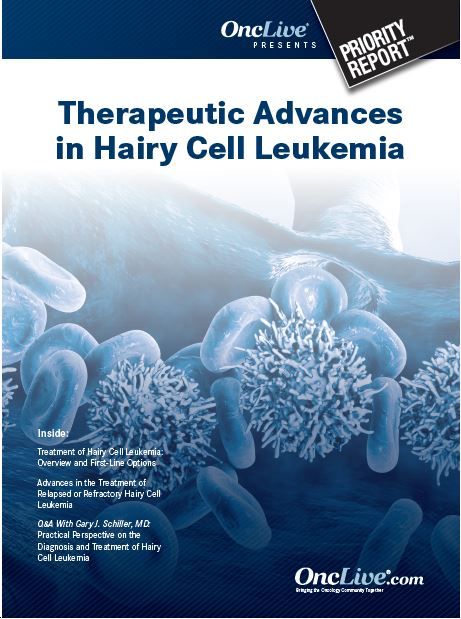Practical Perspectives on the Diagnosis and Treatment of Hairy Cell Leukemia
Gary J. Schiller, MD, discusses the challenges with treating patients with hairy cell leukemia and some emerging therapies that could impact clinical practice.

Gary J. Schiller, MD
In hairy cell leukemia (HCL) treatment, challenges that currently exist involve making the diagnosis as well as predicting the time of relapse, explained Gary J. Schiller, MD.
Moreover, research is ongoing to develop therapeutics that could be associated with less potential for immunosuppression. Moxetumomab pasudotox, for example, is a novel agent with an entirely different mechanism of action and BRAF inhibitors are also gaining traction in the space.
In an interview with OncLive, Schiller, director, Bone Marrow/Stem Cell TransplantationProfessor, Hematology-Oncology, David Geffen School of Medicine, University of California, Los Angeles, discussed the challenges with treating patients with HCL and some emerging therapies that could impact clinical practice.
OncLive®: Hairy cell leukemia (HCL) is such a rare form of leukemia. Can you discuss some challenges regarding its assessment and diagnosis?
Schiller: I think the biggest challenge with HCL is making the diagnosis. We have the technology, we have the capability of making the diagnosis, and most patients who have HCL have a neoplastic clone identifiable in the bone marrow and/or blood. But the problem is awareness. I have discovered that a number of patients have a history of unexplained leukopenia for a period of time, usually neutropenia, but [no clinician made a] designated request for evaluation by pathology specifically for HCL. You may have a bone matter biopsy procured and submitted, but if the pathologist isn’t informed that you are thinking of HCL, you will often not give the necessary clues for making the diagnosis. You really need to advise your hematopathologist, in some form or another, that you are looking for distinct clonal diseases, such as HCL or large granular lymphocytosis, that might not make themselves manifest on a routine Wright’s stain or hematoxylin—eosin stain of aspirate and biopsy, respectively.
What are the core principles of treating HCL, both initially and in follow-up?
Our initial therapy, once we’ve made a diagnosis and the patient either has an abnormal blood test or is symptomatic from HCL, is the purine nucleoside drug cladribine. We have evolved now toward the 5-day, brief intravenous [IV] infusion daily, rather than the 7-day continuous infusion, just for ease; [a patient] treated with the 5 brief daily IV doses does not require sustained venous access or for us to arrange getting a pump. We give prophylaxis for zoster, fungal infections, and pneumocystis for up to a year after that 5-day infusion. For patients who have a feasibility issue, meaning they can’t come daily, we might use pentostatin. Perhaps if somebody were profoundly neutropenic, pentostatin might be preferred because its onset of activity is slower in terms of response but also in the induction and exacerbation of neutropenia.
Can you talk about the prevalence of relapsing or refractory HCL and the challenges of treatment?
The prevalence of relapsing disease depends on the duration of follow-up. If you follow patients for many, many years, I would say that a good one-third to one-half of them will experience overt disease relapse. Relapse can occur anywhere between 2 years and 20 years after initial therapy, and its timing is highly heterogenous. It is not so easy to predict when someone will relapse. Investigators report that residual disease predicts relapse, but I’m not sure I believe that since, even with residual disease, the time to relapse can be very long. I don’t look for residual disease at 3 or 6 months after the purine nucleoside drugs. Instead, I am looking for recovery and normalization of peripheral blood counts; that’s an endpoint to me, and that endpoint can be sustained for a long time with or without evidence of residual bone marrow disease. Treatment is sufficiently immunosuppressive, so a physician needs a pretty good reason for retreating a vulnerable patient. The presence of morphologic disease in the marrow at 3 or 6 months with complete normalization of the blood count is not a satisfactory reason to retreat, but I am sure different experts have different opinions. Without a large series of well-controlled studies, it is difficult to know the meaning and the impact of residual disease. I have had enough patients who have had [residual] disease at 3 or 6 months after cladribine and had a normalization of blood counts for many, many years.
In what situations would you consider a combination regimen for treatment of HCL?
I would consider combinations in the setting of early relapse or disease refractory to purine nucleoside drugs, not in initial management. I am uncertain as to what the advantage might be. Some rare patients might have leukocytosis; for them, you might consider a double indication regimen. But the setting in which I have seen extreme leukocytosis has been in patients with advanced disease, usually those with early relapse, or those with a longstanding history of HCL with multiple relapses after many treatments. Their disease can appear as a relapse with white counts in the 30,000 to 50,000 range; for them, you might consider combination purine nucleoside therapy and rituximab. The immunosuppressive effects are the downside of this combination regimen.
Can you talk about the role of moxetumomab pasudotox and how it differs from the other therapies available for relapsed or refractory HCL?
Moxetumomab pasudotox is a fundamentally different therapy with a completely different mechanism of action. It is a monoclonal antibody with a reactive chemotherapeutic payload. Its potential efficacy in patients whose disease is resistant to purine nucleosides or rituximab is entirely based on that theoretical mechanism of action. It produces responses in patients whose disease has progressed with these initial agents. I cannot really tell you how this novel agent would compare with a BRAF inhibitor; I don’t think we have any data directly addressing the comparison. Moxetumomab has, on the other hand, some off-target toxicity that you need to think about, however uncommon. For instance, there is some potential for hemolytic uremic syndrome, which has been associated with treatment with moxetumomab pasudotox.
As we look to the next several years, how do you expect the treatment spectrum to evolve? What would you like to see emphasized in the guideline or future research?
It might be nice to find a way to deliver a drug that would be associated with less potential for immunosuppression. There would be room in the upfront management to consider a trial of either a BRAF inhibitor or moxetumomab pasudotox.
How important is communication and awareness when it comes to making an HCL diagnosis?
To make a diagnosis of HCL, you need to [first] consider the [possibility of a] diagnosis of HCL. You need to interact with the hematopathologist and make it clear that in your evaluation of neutropenia, when you do a bone marrow biopsy, you specifically ask the hematopathologist to look for HCL as well as large granular lymphocytosis and hypocellular myelodysplasia. Now, in the era of the electronic health record and electronic ordering, I think the greatest risk is to be unable to communicate and to miss the diagnosis. Once the diagnosis is made, we have a lot of treatment options, but we only have one class of agents approved for the initial management, and in the relapse setting we have drugs that are effective. The disease is chronic; people live a long time with it. Later in the disease, leukocytosis can be a problem, although not typically early in the diagnosis. These patients do need to be chronically followed for the rest of their lives. n




